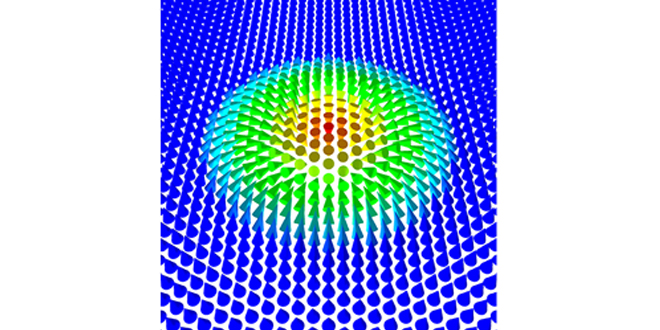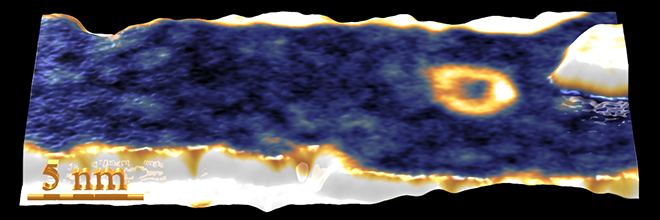Press release
Spontaneous occurrence of magnetic knots discovered
Since their experimental discovery, magnetic skyrmions - tiny magnetic knots - have moved into the focus of research. Scientists from Hamburg and Kiel have now been able to show that individual magnetic skyrmions with a diameter of only a few nanometres can be stabilised in magnetic metal films even without an external magnetic field. They report on their discovery in the journal Nature Communications.
The existence of magnetic skyrmions as particle-like objects was predicted 30 years ago by theoretical physicists, but could only be proven experimentally in 2013. Skyrmions with a diameter from micrometers to a few nanometers were discovered in different magnetic material systems. Although they can be generated on a surface of a few atoms and manipulated with electric currents, they show a high stability against external influences. This makes them potential candidates for future data storage or logic devices. In order to be competitive for technological applications, however, skyrmions must not only be very small, but also stable without an applied magnetic field.
Researchers at the universities of Hamburg and Kiel have now taken an important step in this direction. On the basis of quantum mechanical numerical calculations carried out on the supercomputers of the North-German Supercomputing Alliance (HLRN), the physicists from Kiel were able to predict that individual skyrmions with a diameter of only a few nanometres would appear in an atomically thin, ferromagnetic cobalt film (see Fig. 1). "The stability of the magnetic knots in these films is due to an unusual competition between different magnetic interactions," says Sebastian Meyer, PhD student in Prof. Stefan Heinze's research group at the Kiel University.

Fig. 1: Illustration of a magnetic skyrmion with a diameter of only a few nanometres in an atomically thin cobalt film. The small colored cones represent the "atomic magnets" of each cobalt atom. The ferromagnetic background can be recognized by the blue cones aligned parallel to the top. Within the skyrmion, the "atomic magnets" of the cobalt atoms rotate gradually (green, yellow and orange cones) until they are aligned in the center against the ferromagnetic background (red cones). Copyright: S. Meyer, CAU Kiel.

Fig. 2: Scanning tunneling microscopy measurement of the sample surface, a magnetic skyrmion can be recognized here as a golden ring. The ferromagnetic alignment in the cobalt film outside the skyrmion is blue, the center of the skyrmion is also blue. This three-dimensional view shows in white an atomic step edge (bottom left) and an atomic high island (top right). The bar at the bottom left of the image has a length of five nanometers. Copyright: A. Kubetzka, Universität Hamburg.
Original publication:
S. Meyer, M. Perini, S. von Malottki, A. Kubetzka, R. Wiesendanger, K. von Bergmann, and S. Heinze,
Isolated zero field sub-10 nm skyrmions in ultrathin Co films
Nature Communications, 23.08.2019 (2019).
DOI: 10.1038/s41467-019-11831-4
Further Information:
Professor Dr. Stefan Heinze
Institute of Theoretical Physics and Astrophysics
University of Kiel
Phone: 0431 / 880-4127
E-Mail: heinze@theo-physik.uni-kiel.de
Web: www.itap.uni-kiel.de/theo-physik/heinze
Dr. Kirsten von Bergmann
Department of Physics
University of Hamburg
Phone: 040 / 42838-6295
E-Mail: kbergman@physnet.uni-hamburg.de
Web: https://hp.physnet.uni-hamburg.de/kbergman/
